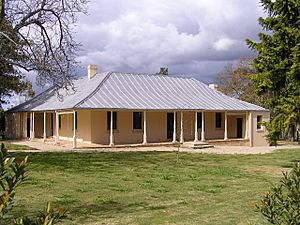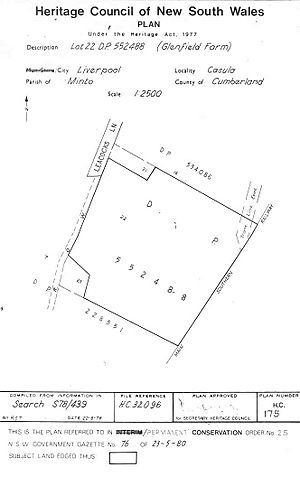Glenfield Farm facts for kids
Quick facts for kids Glenfield Farm |
|
|---|---|
 |
|
| Location | 88 Leacocks Lane, Casula, City of Liverpool, New South Wales, Australia |
| Built | 1810–1817 |
| Owner | Department of Planning and Infrastructure |
| Official name: Glenfield Farm | |
| Type | state heritage (landscape) |
| Designated | 2 April 1999 |
| Reference no. | 25 |
| Type | Homestead Complex |
| Category | Farming and Grazing |
| Builders | Convict labour |
| Lua error in Module:Location_map at line 420: attempt to index field 'wikibase' (a nil value). | |
Glenfield Farm is a historic farm in Casula, Australia. It was built between 1810 and 1817 using the hard work of convicts. Today, it is a special place listed on the New South Wales State Heritage Register since 1999.
Contents
Discovering Glenfield Farm's Past
Glenfield Farm has a long and interesting history, starting with its first owner, Dr. Charles Throsby.
Dr. Charles Throsby: Explorer and Farmer
Dr. Charles Throsby came to New South Wales in 1802 as a surgeon. He worked in places like Castle Hill and Newcastle. In 1809, he left his job as a surgeon.
In 1811, Dr. Throsby received a large piece of land, about 950 acres, in Casula. He named it "Glenfield" after his hometown in England. The main farmhouse was built around 1817.
Dr. Throsby was also a famous explorer. In 1818, he traveled to Jervis Bay, discovering the Wollondilly River. He explored areas around Goulburn and was the first European to visit the area where Canberra is now.
Governor Macquarie was very impressed with Dr. Throsby's discoveries. In 1819, he gave him another 1000 acres of land near Moss Vale.
Dr. Throsby's nephew, also named Charles Throsby, arrived in 1820. He helped manage the family's properties. In 1820, one of Throsby's team members discovered Lake George. Dr. Throsby also heard about the Murrumbidgee River from Aboriginal people, and his nephew reached it in 1821.
Dr. Charles Throsby passed away at Glenfield Farm in 1825 when he was 51 years old. His nephew, Charles, inherited the farm and other properties. Glenfield Farm stayed in the Throsby-Broughton family for many years.
James Leacock and Modern Farming
In 1920, James Leacock bought Glenfield Farm. He was a pioneer in dairy farming in the Liverpool area. In 1909, he started Hygienic Dairies Ltd, which was the first company to supply bottled milk to Sydney.
James Leacock was also interested in organic farming and helping others. Glenfield Farm became a place where people met to discuss important issues. He tried to create a community living and co-operative farming system on the farm.
Even after some of these ideas didn't work out, James Leacock bought the farm back. He lived there until he passed away in 1974. The people living at Glenfield Farm continued to farm the land.
Protecting Glenfield Farm's Heritage
Over the years, Glenfield Farm started to show its age. In the 1980s, efforts began to repair and save the farm. Experts helped fix the roof and other parts of the old buildings.
The farm was opened to the public sometimes, and its farming activities helped support it. Later, some of the land around the farm was used for new houses.
In 2003, the NSW Department of Planning bought the property. In 2006, it was transferred to the NSW Historic Houses Trust. This trust worked to restore the house, bringing it back to its original look.
The restoration work was so good that it won an architecture award in 2008. After being restored, Glenfield Farm was sold to private owners as a home.
Exploring Glenfield Farm's Design
Glenfield Farm is located in Casula, surrounded by Leacock Regional Park. The farm sits on a ridge, offering great views of the valley. It has four main historic brick buildings: the main house, a dairy, stables, and a small toilet building.
The Homestead: A Colonial Home
The main house, called the homestead, has 14 rooms, a kitchen, a pantry, and a cellar. It's built in a style called Colonial Georgian. The roof extends over verandahs on three sides, supported by wooden columns.
You can still see the original wooden roof shingles under the iron roof. The house also has brick cellars and two attic rooms with windows facing the east.
The bricks used to build the house were made from local clay. The mortar, which holds the bricks together, was made from crushed oyster shells. This shows how people used local materials back then.
Inside, the woodwork is made of cedar. There are six-paneled doors and French windows with small glass panes. The decorative carvings around the doors and fireplaces are typical of Colonial Georgian design.
Other Buildings: Farm Life in the Past
Glenfield Farm also has other important buildings that show how it used to operate.
The Barn and Stables
There's a large two-story brick building behind the house. It was likely used as a barn or stables. The ground floor might have held the family carriage and a workshop. The upper floor was probably used for storing hay and animal feed.
This building might have been built a bit later than the main house, perhaps in the 1820s or 1830s.
The Working Farm
Originally, the farm was much larger, about 600 acres. By 1859, it was a busy dairy farm. It had fields for rye, corn, and sugarcane, along with fruit trees and vegetable gardens. There was even an underground dairy to keep butter cool.
Other buildings included pig pens, cow yards, large farm sheds, and a brick stable for four horses with a storage area above.
The Farm's Garden and Landscape
The garden at Glenfield Farm has some old and interesting trees. You can see a large 19th-century Moreton Bay fig tree and early 20th-century pepper trees. There's also an old water tank and terraced areas.
A big clump of giant bamboo marks one edge of the garden. Two Bunya Bunya pine trees stand near the front door of the house. Other trees like silky oaks, African olives, and eucalyptus trees also grow around the homestead.
The farm's entrance gates are a contrast to the modern suburban road. The houses built around the farm in 1988 have changed how Glenfield Farm looks from the west. However, from the east, you can still see the open landscape leading down to Glenfield Creek and the Georges River.
Changes Over Time
Glenfield Farm has seen many changes since it was first built.
- 1809-1817: Dr. Charles Throsby received the land, and the farmhouse was built.
- 1820s: Additions were made to the southern side of the verandah.
- 1859: The farm was leased as a large working dairy farm with many crops and animals.
- Early 1900s: Parts of the farm were sold off.
- 1920: James Leacock bought Glenfield Farm and brought dairy farming to the area.
- 1974: The farm was about 14 acres when James Leacock passed away.
- Around 1983: The roof was repaired, and dormer windows were rebuilt.
- 1984: Leacock's Lane, the main road to the farm, was still unsealed.
- 1988: New houses were built around Glenfield Farm, changing its surroundings.
- 2003: The NSW Department of Planning bought the property.
- 2006: The property was transferred to the NSW Historic Houses Trust for restoration.
- 2008: The restoration won an award, and the house was recognized as one of the most intact houses from the Macquarie period (1810-1821).
- 2006-2008: A new water tank was installed, and the garden's water supply was improved.
Why Glenfield Farm is Important
Glenfield Farm is a very important historical site in New South Wales. It's one of the few old farm complexes that still exists from the early days of European settlement in Australia. It can still be used as a home and for some farming.
- Connection to Key Figures: The farm is linked to Dr. Charles Throsby, a famous explorer, and James Leacock, an innovative dairy farmer.
- Architectural History: Its buildings show us what rural homes and farms looked like in the early 1800s. The main house is one of the oldest continuously lived-in private homes in the state.
- Well-Preserved: It's amazing that all the original buildings are still mostly intact. This makes it very valuable to the community.
- Farm Life: The farm's grounds still show how farming activities were done and how gardens were laid out by different owners.
- Oldest Continuously Worked Farm: Glenfield Farm is considered the oldest continuously worked farm in Australia. Its buildings are among the earliest in the country for their design and quality.
Glenfield Farm was officially listed on the New South Wales State Heritage Register on 2 April 1999, recognizing its special historical value.


